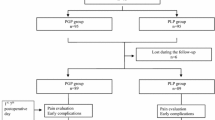Abstract
A standard polypropylene mesh used in Lichtenstein’s operation induces a strong foreign tissue reaction with potential harmful effects. A mesh with less polypropylene could possibly be beneficial. Six hundred men with primary unilateral inguinal hernias were randomised to Lichtenstein’s operation using a Prolene- or Vypro II-mesh in six centres. The patients were blinded to which mesh they received. A validated questionnaire assessing recurrence and pain along with SF-36 Health Survey was sent after 1 year to all patients and a selected group was clinically examined. Of the 591 operated patients, 526 (89.0%) returned the questionnaire. 188 patients had some complaints or sensations of which 111 patients were clinically examined. The mean follow-up time was 13.6 (SD. 4.0) months. The incidence of hernia recurrence (four vs. four patients) and neuralgia (three vs. four patients) did not differ between Prolene and Vypro II-groups, respectively. One Vypro II-patient was re-operated due to neuralgia. There was no difference in the SF-36 scores. The results of Lichtenstein’s operation with either Prolene or Vypro II do not seem to differ significantly.

Similar content being viewed by others
References
Bay-Nielsen M, Nordin P, Nilsson E, Kehlet H (2001) Operative findings in recurrent hernia after a Lichtenstein procedure. Am J Surg 182:134–136
Collaboration EHT (2000) Mesh compared with non-mesh methods of open groin hernia repair: systematic review of randomized controlled trials. Br J Surg 87:854–859
Heise CP, Starling JR (1998) Mesh inguinodynia: a new clinical syndrome after inguinal herniorrhaphy?. J Am Coll Surg 187:514–518
Klinge U, Klosterhalfen B, Muller M, Schumpelick V (1999) Foreign body reaction to meshes used for the repair of abdominal wall hernias. Eur J Surg 165:665–673
Junge K, Klinge U, Rosch R, Klosterhalfen B, Schumpelick V (2002) Functional and morphologic properties of a modified mesh for inguinal hernia repair. World J Surg 26:1472–1480
Schumpelick V, Klinge U (2003) Prosthetic implants for hernia repair. Br J Surg 90:1457–1458
Amid PK, Shulman AG, Lichtenstein IL (1996) Open “tension-free” repair of inguinal hernias: the Lichtenstein technique. Eur J Surg 162:447–453
Sullivan M, Karlsson J (1994) SF-36 Hälsoenkät Manual och tolkningsguide. Sektionen för vårdforskning, Sahlgrenska sjukhuset, Göteborg, Sweden, Göteborg, pp 7:10
Sullivan M, Karlsson J (1998) The Swedish SF-36 Health Survey III Evaluation of criterion-based validity: results from normative population. J Clin Epidemiol 51:1105–1113
Bringman S, Heikkinen TJ, Wollert S, Osterberg J, Smedberg S, Granlund H, Ramel S, Fellander G, Anderberg B (2004) Early results of a single-blinded, randomized, controlled, Internet-based multicenter trial comparing Prolene and Vypro II mesh in Lichtenstein hernioplasty. Hernia 8:127–134
Kald A, Nilsson E (1991) Quality assessment in hernia surgery. Qual Assur Health Care 3:205–210
Bringman S, Ek A, Haglind E, Heikkinen T, Kald A, Kylberg F, Ramel S, Wallon C, Anderberg B (2001) Is a dissection balloon beneficial in totally extraperitoneal endoscopic hernioplasty (TEP)? A randomized prospective multicenter study. Surg Endosc 15:266–270
Johansson B, Hallerback B, Glise H, Anesten B, Smedberg S, Roman J (1999) Laparoscopic mesh versus open preperitoneal mesh versus conventional technique for inguinal hernia repair: a randomized multicenter trial (SCUR Hernia Repair Study). Ann Surg 230:225–231
Collaboration EHT (2002) Repair of groin hernia with synthetic mesh: meta-analysis of randomized controlled trials. Ann Surg 235:322–332
Poobalan AS, Bruce J, King PM, Chambers WA, Krukowski ZH, Smith WC (2001) Chronic pain and quality of life following open inguinal hernia repair. Br J Surg 88:1122–1126
Callesen T, Bech K, Andersen J, Nielsen R, Roikjaer O, Kehlet H (1999) Pain after primary inguinal herniorrhaphy: influence of surgical technique. J Am Coll Surg 188:355–359
Bringman S, Ramel S, Heikkinen TJ, Englund T, Westman B, Anderberg B (2003) Tension-Free Inguinal Hernia Repair: TEP Versus Mesh-Plug Versus Lichtenstein: A Prospective Randomized Controlled Trial. Ann Surg 237:142–147
Sullivan M, Karlsson J (1994) SF-36 Hälsoenkät Manual och tolkningsguide. Sektionen för vårdforskning, Sahlgrenska sjukhuset, Göteborg, Sweden, Göteborg
Acknowledgements
The authors are grateful to RN Cajsa Barthelsson, RN Christina Lindblom, RN Sirpa Jämsä, Secr. Carina Törnkvist. and Secr. Lise-Lotte Lindh, for their skilful work in the study. Financial support: The study was supported by a grant from Ethicon Scandinavia, Ethicon Europe and from the County Council of Stockholm.
Author information
Authors and Affiliations
Corresponding author
Rights and permissions
About this article
Cite this article
Bringman, S., Wollert, S., Österberg, J. et al. One year results of a randomised controlled multi-centre study comparing Prolene and Vypro II-mesh in Lichtenstein hernioplasty. Hernia 9, 223–227 (2005). https://doi.org/10.1007/s10029-005-0324-z
Received:
Accepted:
Published:
Issue Date:
DOI: https://doi.org/10.1007/s10029-005-0324-z




